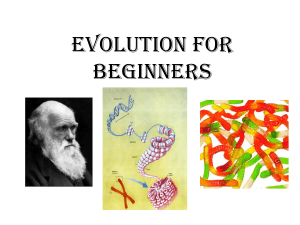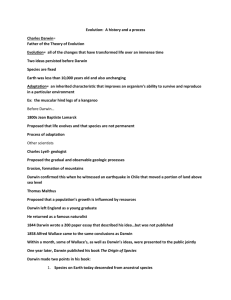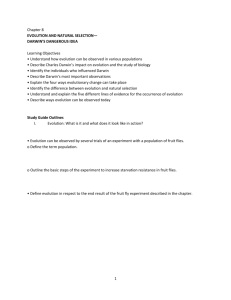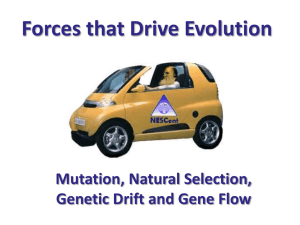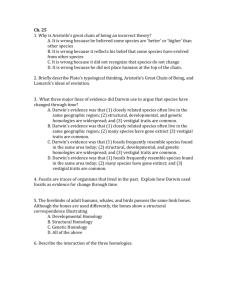Homework one due.
advertisement
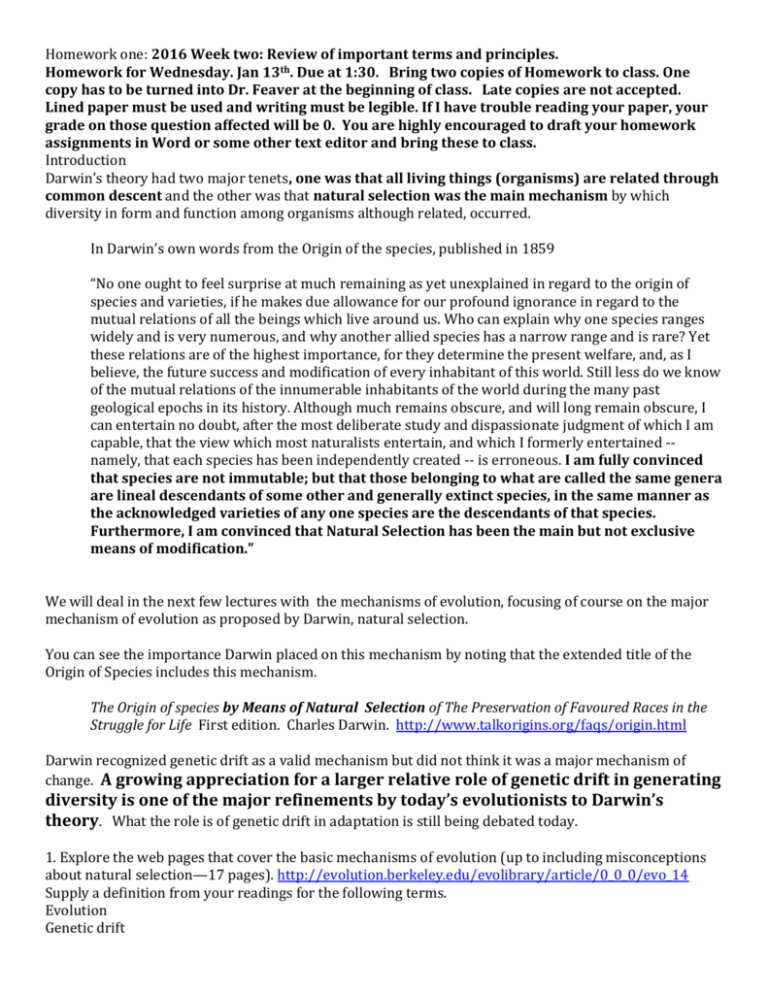
Homework one: 2016 Week two: Review of important terms and principles. Homework for Wednesday. Jan 13th. Due at 1:30. Bring two copies of Homework to class. One copy has to be turned into Dr. Feaver at the beginning of class. Late copies are not accepted. Lined paper must be used and writing must be legible. If I have trouble reading your paper, your grade on those question affected will be 0. You are highly encouraged to draft your homework assignments in Word or some other text editor and bring these to class. Introduction Darwin’s theory had two major tenets, one was that all living things (organisms) are related through common descent and the other was that natural selection was the main mechanism by which diversity in form and function among organisms although related, occurred. In Darwin’s own words from the Origin of the species, published in 1859 “No one ought to feel surprise at much remaining as yet unexplained in regard to the origin of species and varieties, if he makes due allowance for our profound ignorance in regard to the mutual relations of all the beings which live around us. Who can explain why one species ranges widely and is very numerous, and why another allied species has a narrow range and is rare? Yet these relations are of the highest importance, for they determine the present welfare, and, as I believe, the future success and modification of every inhabitant of this world. Still less do we know of the mutual relations of the innumerable inhabitants of the world during the many past geological epochs in its history. Although much remains obscure, and will long remain obscure, I can entertain no doubt, after the most deliberate study and dispassionate judgment of which I am capable, that the view which most naturalists entertain, and which I formerly entertained -namely, that each species has been independently created -- is erroneous. I am fully convinced that species are not immutable; but that those belonging to what are called the same genera are lineal descendants of some other and generally extinct species, in the same manner as the acknowledged varieties of any one species are the descendants of that species. Furthermore, I am convinced that Natural Selection has been the main but not exclusive means of modification.” We will deal in the next few lectures with the mechanisms of evolution, focusing of course on the major mechanism of evolution as proposed by Darwin, natural selection. You can see the importance Darwin placed on this mechanism by noting that the extended title of the Origin of Species includes this mechanism. The Origin of species by Means of Natural Selection of The Preservation of Favoured Races in the Struggle for Life First edition. Charles Darwin. http://www.talkorigins.org/faqs/origin.html Darwin recognized genetic drift as a valid mechanism but did not think it was a major mechanism of change. A growing appreciation for a larger relative role of genetic drift in generating diversity is one of the major refinements by today’s evolutionists to Darwin’s theory. What the role is of genetic drift in adaptation is still being debated today. 1. Explore the web pages that cover the basic mechanisms of evolution (up to including misconceptions about natural selection—17 pages). http://evolution.berkeley.edu/evolibrary/article/0_0_0/evo_14 Supply a definition from your readings for the following terms. Evolution Genetic drift Natural selection Gene or allele frequency Mutation Genetic recombination (sexual reproduction) Fitness Adaptation Artificial selection Species Again, please turn in one copy of the definitions above in at the beginning of class. You should place the definitions next to the definitions you wrote down the second day of class. You may simply xerox this documents to turn in for homework. Make sure your name is on the document. For class You should also be able to apply these terms. Application demands understanding and not simple memorization. Think about the following questions as you move through the section on mechanisms. Before class on Monday, you should visit the websites associated with the questions we will discuss. Make no attempt to memorize the material on the website. We will revisit them in class when we talk about the questions. We may get to questions 2- 5 on Wednesday, the others on Friday. Come prepared to discuss the following questions in class. The answers to these questions will be the focus of class discussion and not part of your homework assignment that needs to be turned in at the beginning, of class. 2. A definition for natural selection that is often found in textbooks is differential reproduction. Is this an acceptable definition for you? How would you modify it to be a more acceptable representation of how selection brings about evolutionary change? Defend your answer. 3. Popular literature often defines natural selection as survival of the fittest. Is this a more accurate definition than differential reproduction? 4. Although the website holds that there are four mechanisms of evolutionary change your instructor holds that only two, genetic drift and natural selection, can result in the long term historic changes that characterize the diversity we see among species. Do you agree? 5. What are the necessary conditions for natural selection? http://evolution.berkeley.edu/evolibrary/article/0_0_0/evo_32 https://www.blackwellpublishing.com/ridley/tutorials/Natural_selection_and_variation5.asp to https://www.blackwellpublishing.com/ridley/tutorials/Natural_selection_and_variation6.asp What would happen (Would for example, the population evolve, if each of these conditions were not met to a population facing environmental change? 6. The connection between evolution and natural selection. https://www.blackwellpublishing.com/ridley/tutorials/Natural_selection_and_variation7.asp to https://www.blackwellpublishing.com/ridley/tutorials/Natural_selection_and_variation11.asp Directional selection is seen as a force for evolution, stabilizing as a force against. Why? Would it make a difference if you saw evolution as simple change in biology over time or a change in gene frequency? 7. On fitness a. One pair of birds fosters tender loving care on the two children they have every breeding season. Unfortunately, despite their care only 4 children live to reproduce. b. In another related species, pairs live only one season and have 12 -15 young. You follow two pairs. One pair during their lifetime has 12 young but also leave 4 young that live to reproduce. c. The other pair has 15 young, 7 survive, but only 5 so far have reproduced themselves Which pair of the three would you judge most fit? Which strategy, a or b, would you judge most fit? How would you go about representing fitness mathematically? 8. Go to the website http://evolution.berkeley.edu/evolibrary/article/sneakermales_01 How would you begin to evaluate the fitness of these two different types of males? 9. When we talk about parental care strategies, are we discussing natural or sexual selection? How would you tell the difference between the two?
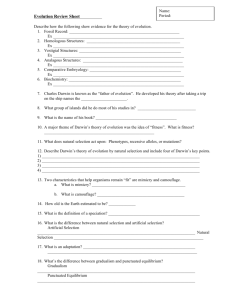


![Evolution Review Sheet [17.5 points]](http://s3.studylib.net/store/data/006844228_1-297d91d8d42ebb7a3d5ae1e01d293b2f-300x300.png)


